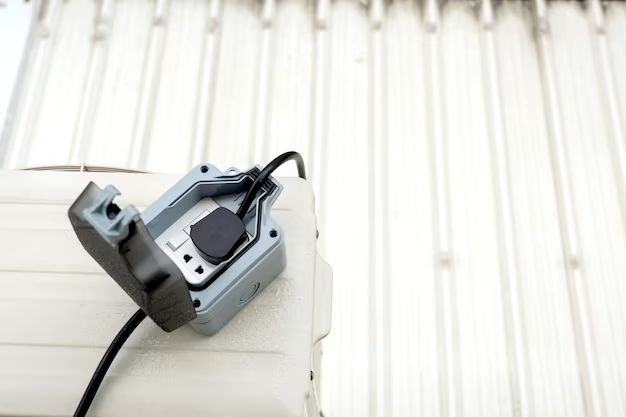Waterproofing an outlet box is an important step in preventing water damage and potential electrical hazards in your home. While there are several methods for waterproofing outlet boxes, the key steps usually involve sealing openings and gaps, redirecting moisture, and using waterproof materials. In this article, we will walk through the main steps for properly waterproofing an outlet box.
Page Contents
- 1 Materials Needed
- 2 Step 1: Shut Off Power
- 3 Step 2: Remove the Outlet Cover
- 4 Step 3: Check for Gaps and Openings
- 5 Step 4: Seal Gaps and Openings
- 6 Step 5: Install Drip Loop
- 7 Step 6: Weatherproof Conduit Connections
- 8 Step 7: Install a Weatherproof Cover
- 9 Step 8: Test and Restore Power
- 10 Outdoor and Wet Location Outlet Boxes
- 11 Extra Outdoor Protection
- 12 Hiring an Electrician
- 13 Safety Tips
- 14 Conclusion
Materials Needed
Here are some of the common materials you will need to waterproof an outlet box:
- Caulk or silicone sealant – To seal gaps and openings
- Spray foam sealant – To fill larger gaps
- Electrical tape – To cover openings and seams
- Weatherproof outlet covers – Covers with gaskets to prevent moisture
- Drip loops – To redirect moisture away from the box
- Conduit fittings – Waterproof conduit connections
Step 1: Shut Off Power
The first step is to shut off power to the outlet at the main breaker panel. This ensures you can work safely on the outlet box without risk of shock.
Step 2: Remove the Outlet Cover
With the power shut off, go ahead and remove the outlet cover plate so you can access the full outlet box.
Step 3: Check for Gaps and Openings
Examine the outlet box carefully and look for any gaps, holes, or openings where moisture could enter. This includes:
- Around wires entering the box
- Between the box and the wall surface
- Cracks in the box itself
- Open knockouts
Step 4: Seal Gaps and Openings
Use caulk, silicone sealant, or spray foam to thoroughly seal any identified gaps or openings. Here are some tips when sealing:
- Remove any debris or dirt first so the sealant adheres properly.
- Apply sealant carefully to avoid getting it on electrical components.
- Spray foam can be used for larger gaps before trimming the excess.
- Use electrical tape over openings and seams for an extra layer of protection.
Step 5: Install Drip Loop
A drip loop redirects moisture away from an outlet box by having wires enter from the bottom rather than the top. To add a drip loop:
- Loosen the cable clamps for existing wires entering from the top.
- Carefully pull the wires further into the box so they now enter through the bottom knockout.
- Re-secure the cable clamps.
Step 6: Weatherproof Conduit Connections
For outlet boxes with conduit connections, be sure those connections are properly sealed by:
- Applying sealant around the conduit fittings.
- Using waterproof conduit fittings rated for wet locations.
- Wrapping electrical tape around the conduit joints.
Step 7: Install a Weatherproof Cover
Replace the standard outlet cover with a weatherproof outlet cover. These covers form a seal against moisture intrusion.
- Look for covers labeled “extra duty” or “in-use” for outdoor outlets.
- Covers with foam gaskets provide better sealing.
- Make sure the cover fits flush against the box and wall.
Step 8: Test and Restore Power
With all waterproofing measures complete, restore power and test the outlet. Verify it is operating correctly before leaving the site.
Be sure to re-check the seals and connections periodically to ensure ongoing weather protection.
Outdoor and Wet Location Outlet Boxes
For outlets exposed to heavy weather or constantly wet conditions, consider upgrading to a specialized wet location or outdoor outlet box.
These boxes have enhanced waterproof designs such as:
- Rain-tight gaskets and seals
- Deeper covers to accommodate plugs
- Drain holes to prevent moisture buildup
- Corrosion-resistant materials
Wet location boxes allow for easier, more reliable waterproofing than trying to modify standard boxes.
Extra Outdoor Protection
For outdoor outlets, also consider adding:
- A weatherproof in-use cover for outdoor outlets in use.
- GFCI protection for safety.
- Surge protector to protect against electrical spikes.
- Mounting the box sideways to prevent water pooling on the cover.
Hiring an Electrician
Waterproofing outlet boxes requires working with electrical wiring, so if you are uncomfortable doing this yourself it is best to hire a licensed electrician.
Professionals have the tools, knowledge, and experience to:
- Accurately locate gaps and openings.
- Safely seal boxes while avoiding contact with wires.
- Evaluate if a box should be replaced entirely.
- Ensure waterproofing meets local electrical code.
They can also install specialized outdoor boxes and fixtures if needed.
Safety Tips
Keep these safety tips in mind when waterproofing electrical boxes:
- Always shut off the power first at the breaker panel.
- Be careful not to get any sealant on the wires themselves.
- Do not caulk over knockouts if they are needed for new wiring.
- Only spray foam small gaps, not entire boxes or conduits.
- Always test outlets thoroughly before leaving the site.
Conclusion
Protecting electrical outlets from moisture is an important home safety task. By thoroughly sealing openings, redirecting entry points, and utilizing waterproof materials, you can help prevent electrical hazards and keep outlets working properly. Pay close attention to detail when waterproofing and consider hiring a professional electrician for best results. With the right techniques, you can give outlet boxes the waterproof protection they need to last.
